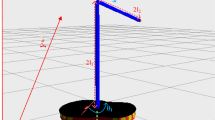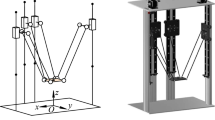Abstract
Control of flexible multibody systems, such as flexible manipulators, is a challenging task. This is especially true if end-effector trajectory tracking is aspired. On the one hand, these systems require a large number of generalized coordinates to describe their dynamical behavior accurately. On the other hand, only a small subset of these values can be measured or reconstructed on-the-fly. Hence, it is difficult, if not nearly impossible, to use a state controller. In addition, flexible systems are underactuated, i.e. they possess less control inputs than generalized coordinates. In case of a non-collocated output controller, which is the case for end-effector trajectory tracking, the closed loop of the system might lose passivity and is non-minimum phase. In order to achieve end-effector trajectory tracking, exact and approximate feed-forward controls can be applied. In this work, two different versions of such concepts are compared experimentally. These model-based concepts are computed off-line and they supply, next to the required input values, a C1-continuous solution of the complete state vector which can be used for feedback control. If the system is non-minimum phase, a two-sided boundary value problem has to be solved and the solution includes a pre-actuation as well as a post-actuation phase. While the exact method incorporates all dynamical effects of the flexible multibody system, the approximate concepts neglect certain implications, for example the dynamical effects due to the flexibility. In addition to the presentation of the theoretical basics of the control approaches and the underlying models, this contribution addresses some of the crucial obstacles, which have to be overcome for the operation of the test bench, e.g., signal conditioning, state reconstruction and friction compensation. Since the installed sensors do not allow the direct measurement of the endeffector position, image tracking is used to judge the quality of the different control approaches.
Similar content being viewed by others
References
R. Seifried, Dynamics of underactuated multibody systems, Springer, Berlin (2014).
J. Blanchette and M. Summerfield, C++ GUI Programming with Qt4, Second Ed., Prentice Hall, Upper Saddle River (2008).
Modbus: Modbus application protocol application V1.1b3, Available at: http://www.modbus.org/ (2012).
M. W. Spong, S. Hutchinson and M. Vidyasagar, Robot modeling and control, John Wiley & Sons, Hoboken (2006).
T. Kurz, P. Eberhard, C. Henninger and W. Schiehlen, From Neweul to Neweul-M2: symbolical equations of motion for multibody system analysis and synthesis, Multibody System Dynamics, 24 (1) (2010) 25–41.
M. Burkhardt, P. Holzwarth and R. Seifried, Inversion based trajectory tracking control for a parallel kinematic manipulator with flexible links, Proc. of the 11th International Conference on Vibration Problems, Lisbon, Portugal (2013).
W. Blajer and K. Kolodziejczyk, A geometric approach to solving problems of control constraints: theory and a DAE framework, Multibody System Dynamics, 11 (4) (2004) 343–364.
C. J. Damaren, Passivity and noncollocation in the control of flexible multibody systems, Journal of Dynamic Systems, Measurement, and Control, 122 (1) (2000) 11–17.
R. Seifried, M. Burkhardt and A. Held, Trajectory control of serial and parallel flexible manipulators using model inversion, J. C. Samin and P. Fisette (Eds.), Multibody Dynamics: Computational Methods and Applications, Computational Methods in Applied Sciences 28, Springer, Berlin (2013) 53–75.
B. Bona and M. Indri, Friction compensation in robotics: an overview, Proc. of the 44th IEEE Conference on Decision and Control, and the European Control Conference, Seville, Spain (2005) 4360–4367.
M. S. Grewal and A. P. Andrews, Kalman filtering: theory and practice using MATLAB, John Wiley & Sons, Hoboken, USA (2011).
R. A. Singer, Estimating optimal tracking filter performance for manned maneuvering, Target Hughes Aircraft Company (1970).
X. R. Li and V. P. Jilkov, A survey of maneuvering target tracking: dynamic models, Proc. of SPIE Conference on Signal and Data Processing of Small Targets, Orlando, USA (2000) 212–235.
A. Ast and P. Eberhard, Flatness-based control of parallel kinematics using multibody systems–simulation and experimental results, Archive of Applied Mechanics, 76 (3-4) (2006) 181–197.
Author information
Authors and Affiliations
Corresponding author
Additional information
This paper was presented at the Joint Conference of the 3rd IMSD and the 7th ACMD, Busan, Korea, June, 2014. Recommended by Guest Editor Sung-Soo Kim and Jin Hwan Choi
Markus Burkhardt is a research assistant at the Institute of Engineering and Computational Mechanics at the University of Stuttgart, Germany. His research topics include modeling and control of flexible multibody systems, differential-algebraic equations, and feedforward control.
Robert Seifried is head of the Institute of Mechanics and Ocean Engineering at the Hamburg University of Technology. His research interests are in flexible multibody dynamics, mechatronics, nonlinear control of under-actuated multibody systems, optimization, structural vibration, wave propagation and discrete element methods.
Peter Eberhard is director of the Institute of Engineering and Computational Mechanics at the University of Stuttgart. His research interests are in multibody dynamics, contact mechanics, optimization, biomechanics, model-order reducetion, and mechatronics as well as various projects with industrial partners.
Rights and permissions
About this article
Cite this article
Burkhardt, M., Seifried, R. & Eberhard, P. Experimental studies of control concepts for a parallel manipulator with flexible links. J Mech Sci Technol 29, 2685–2691 (2015). https://doi.org/10.1007/s12206-015-0515-1
Received:
Revised:
Accepted:
Published:
Issue Date:
DOI: https://doi.org/10.1007/s12206-015-0515-1




